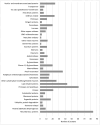Extracellular vesicles of Norway spruce contain precursors and enzymes for lignin formation and salicylic acid
- PMID: 38771246
- PMCID: PMC11444294
- DOI: 10.1093/plphys/kiae287
Extracellular vesicles of Norway spruce contain precursors and enzymes for lignin formation and salicylic acid
Abstract
Lignin is a phenolic polymer in plants that rigidifies the cell walls of water-conducting tracheary elements and support-providing fibers and stone cells. Different mechanisms have been suggested for the transport of lignin precursors to the site of lignification in the cell wall. Extracellular vesicle (EV)-enriched samples isolated from a lignin-forming cell suspension culture of Norway spruce (Picea abies L. Karst.) contained both phenolic metabolites and enzymes related to lignin biosynthesis. Metabolomic analysis revealed mono-, di-, and oligolignols in the EV isolates, as well as carbohydrates and amino acids. In addition, salicylic acid (SA) and some proteins involved in SA signaling were detected in the EV-enriched samples. A proteomic analysis detected several laccases, peroxidases, β-glucosidases, putative dirigent proteins, and cell wall-modifying enzymes, such as glycosyl hydrolases, transglucosylase/hydrolases, and expansins in EVs. Our findings suggest that EVs are involved in transporting enzymes required for lignin polymerization in Norway spruce, and radical coupling of monolignols can occur in these vesicles.
© The Author(s) 2024. Published by Oxford University Press on behalf of American Society of Plant Biologists.
Conflict of interest statement
Conflict of interest statement. None declared.
Figures








Similar articles
-
Norway spruce (Picea abies) laccases: characterization of a laccase in a lignin-forming tissue culture.J Integr Plant Biol. 2015 Apr;57(4):341-8. doi: 10.1111/jipb.12333. J Integr Plant Biol. 2015. PMID: 25626739
-
Cell wall lignin is polymerised by class III secretable plant peroxidases in Norway spruce.J Integr Plant Biol. 2010 Feb;52(2):186-94. doi: 10.1111/j.1744-7909.2010.00928.x. J Integr Plant Biol. 2010. PMID: 20377680 Review.
-
Characterization of basic p-coumaryl and coniferyl alcohol oxidizing peroxidases from a lignin-forming Picea abies suspension culture.Plant Mol Biol. 2005 May;58(2):141-57. doi: 10.1007/s11103-005-5345-6. Plant Mol Biol. 2005. PMID: 16027971
-
Ray Parenchymal Cells Contribute to Lignification of Tracheids in Developing Xylem of Norway Spruce.Plant Physiol. 2019 Dec;181(4):1552-1572. doi: 10.1104/pp.19.00743. Epub 2019 Sep 26. Plant Physiol. 2019. PMID: 31558578 Free PMC article.
-
Trends in lignin modification: a comprehensive analysis of the effects of genetic manipulations/mutations on lignification and vascular integrity.Phytochemistry. 2002 Oct;61(3):221-94. doi: 10.1016/s0031-9422(02)00211-x. Phytochemistry. 2002. PMID: 12359514 Review.
Cited by
-
When the going gets tough: Extracellular vesicles transport lignin precursors and lignifying enzymes.Plant Physiol. 2024 Oct 1;196(2):675-676. doi: 10.1093/plphys/kiae354. Plant Physiol. 2024. PMID: 38935587 Free PMC article. No abstract available.
-
The role of plant extracellular vesicles in cell wall remodeling.Extracell Vesicles Circ Nucl Acids. 2025 May 28;6(2):267-271. doi: 10.20517/evcna.2025.17. eCollection 2025. Extracell Vesicles Circ Nucl Acids. 2025. PMID: 40852598 Free PMC article.
-
Infection of Norway spruce by Chrysomyxa rhododendri: ultrastructural insights into plant-pathogen interactions reveal differences between resistant and susceptible trees.Tree Physiol. 2025 Jul 1;45(7):tpaf066. doi: 10.1093/treephys/tpaf066. Tree Physiol. 2025. PMID: 40459247 Free PMC article.
-
A Compendium of Bona Fide Reference Markers for Genuine Plant Extracellular Vesicles and Their Degree of Phylogenetic Conservation.J Extracell Vesicles. 2025 Sep;14(9):e70147. doi: 10.1002/jev2.70147. J Extracell Vesicles. 2025. PMID: 40903814 Free PMC article.
-
Metabolite differences and molecular mechanism between dehiscent and indehiscent capsule of mature sesame.Food Chem (Oxf). 2024 Nov 26;9:100231. doi: 10.1016/j.fochms.2024.100231. eCollection 2024 Dec 30. Food Chem (Oxf). 2024. PMID: 39687584 Free PMC article.
References
-
- Bachurski D, Schuldner M, Nguyen PH, Malz A, Reiners KS, Grenzi PC, Babatz F, Schauss AC, Hansen HP, Hallek M, et al. . Extracellular vesicle measurements with nanoparticle tracking analysis—an accuracy and repeatability comparison between NanoSight NS300 and ZetaView. J Extracell Vesicles. 2019:8(1):1596016. 10.1080/20013078.2019.1596016 - DOI - PMC - PubMed
-
- Berthet S, Demont-Caulet N, Pollet B, Bidzinski P, Cézard L, Le Bris P, Borrega N, Hervé J, Blondet E, Balzergue S, et al. . Disruption of LACCASE4 and 17 results in tissue-specific alterations to lignification of Arabidopsis thaliana stems. Plant Cell. 2011:23(3):1124–1137. 10.1105/tpc.110.082792 - DOI - PMC - PubMed
MeSH terms
Substances
Grants and funding
LinkOut - more resources
Full Text Sources

